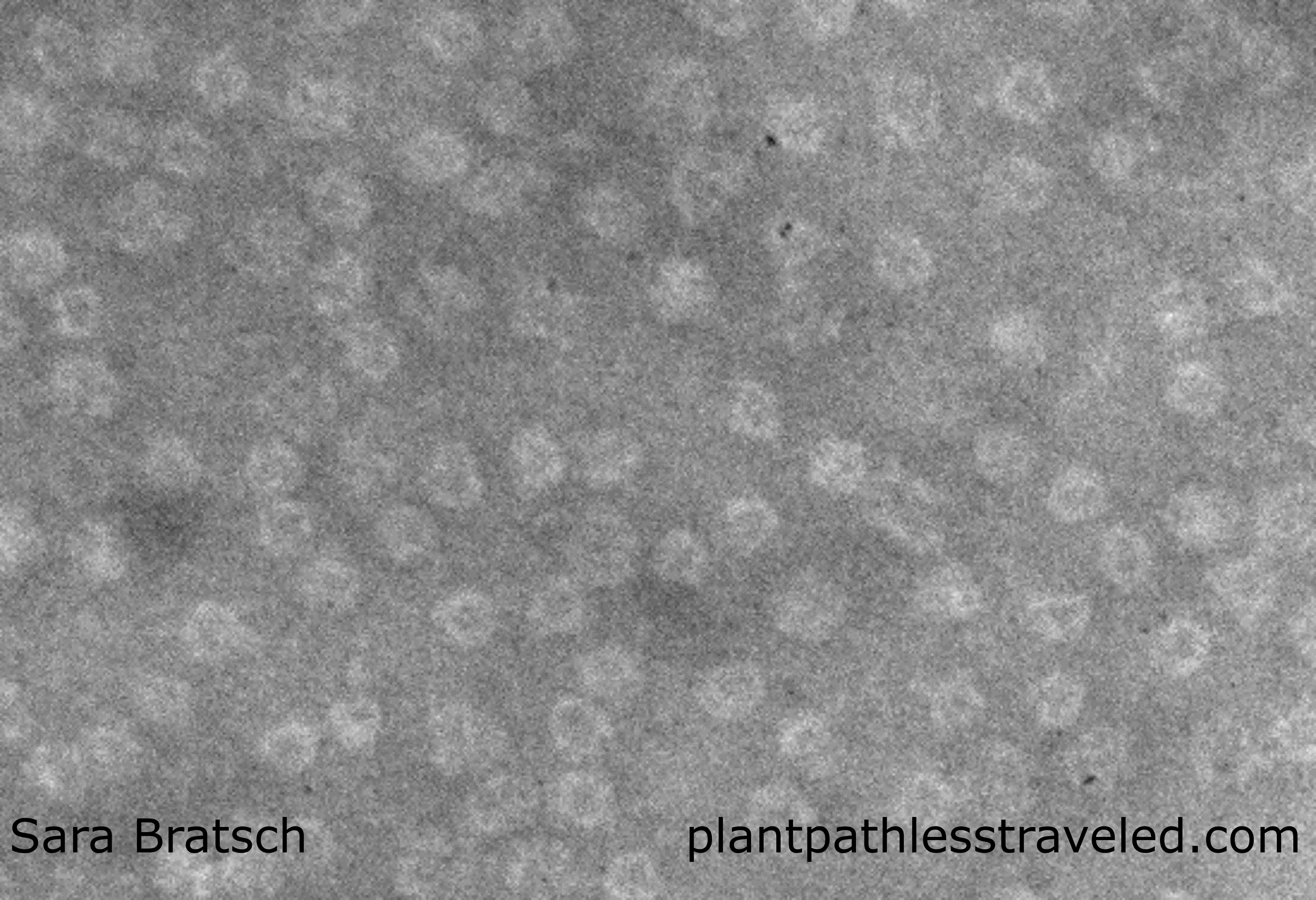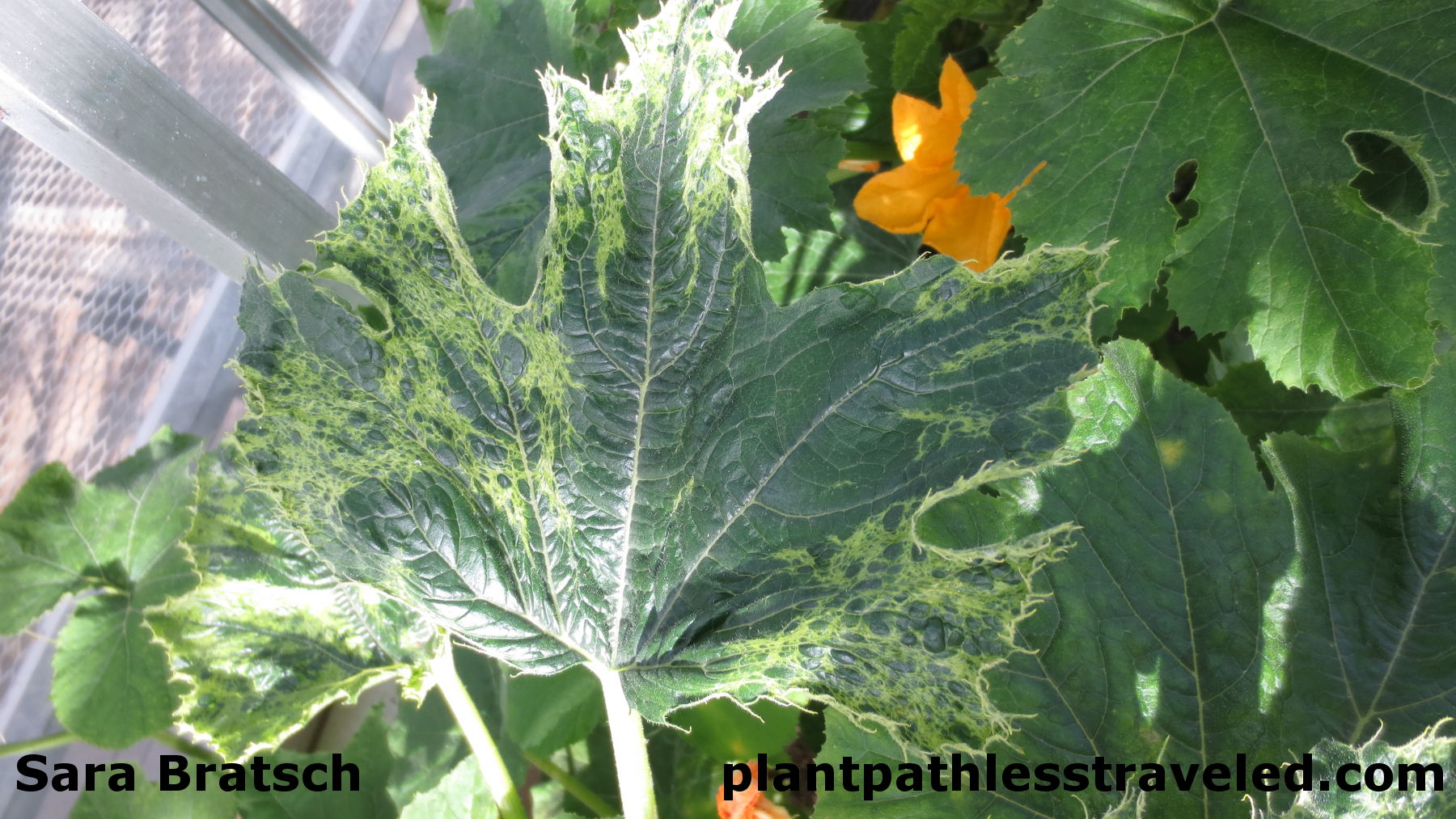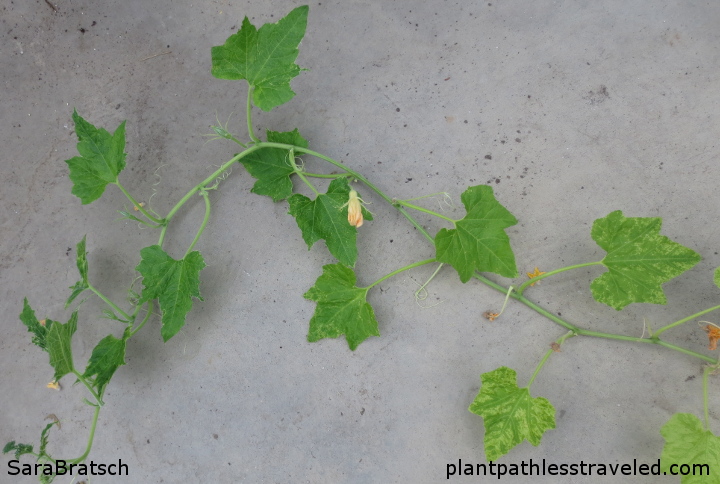Squash Mosaic Virus Part 2 (SqMV)
Squash mosaic virus (SqMV) is a plant virus found in Cucurbitaceae plants worldwide. SqMV produces both leaf and fruit symptoms ranging from mottling to deformation. It can be spread by both seed and beetles. Control measures include planting only virus-tested seed, rouging infected plants early, and keeping the beetle population low before fruits set to prevent infecting the fruit.
Introduction
Squash mosaic virus (abbreviated SqMV) is a common virus found in cucurbit plants. SqMV was first described by a scientist named Kendrick in 1934 but it was not until 1941 that Freitag identified the causal virus. SqMV continues to be found in cucurbit crops today. SqMV is a spherical virus with particles ~30 nm in diameter (Campbell 1971).
 Squash mosaic virus from a partially purified squash extract that is stained with PTA. This image was taken at 53,000 times magnification. The virus particles are the round structures.
Squash mosaic virus from a partially purified squash extract that is stained with PTA. This image was taken at 53,000 times magnification. The virus particles are the round structures.
Symptoms
Infected plant leaves may be symptomless or show ring patterns, chlorotic mottle, deformation, vein clearing, or streaking. Fruit that is infected at or before blossoming will show symptoms including color change, bumps, and other distortion. Plants infected after fruit have set will show symptoms in the leaves but the fruit will not develop symptoms.
 Zucchini infected with SqMV showing severe foliar symptoms of deformation, bumps, and chlorotic mottling.
Zucchini infected with SqMV showing severe foliar symptoms of deformation, bumps, and chlorotic mottling.
 ‘Jack be little’ pumpkin infected with SqMV. Note the variation in leaf symptoms between old leaves (right side) and newer leaves (left side).
‘Jack be little’ pumpkin infected with SqMV. Note the variation in leaf symptoms between old leaves (right side) and newer leaves (left side).
 Yellow squash fruit that tested positive for SqMV showing bumps and color change.
Yellow squash fruit that tested positive for SqMV showing bumps and color change.
Host
The natural host range of SqMV is extremely limited and includes only the Cucurbitaceae family (squashes, pumpkins, melons, gourds) (Campbell 1971). Experimentally SqMV has been transmitted to the plant families: Amaranthaceae, Chenopodiaceae, Hydrophyllaceae, Leguminosae, and Umbelliferae (Frietag 1956). One report from Morocco has also transmitted SqMV by mechanical inoculation to Chenopodium quinoa Willd. where it systemically infected the plants and produced symptoms (Lockhart, Ferji, Hafidi 1982).
Control
SqMV is seed transmitted with a transmission rate ranging from 1%-94% transmission (Grogan, Hall & Kimble 1959; Rayder, Fitzpatrick & Hildebrand 1947). It can be transmitted within a field from infected plants by various beetle species including: western striped cucumber beetle (Acalymma trivittata Mann.), western twelve-spotted cucumber beetle (Diabrotica undecimpunctata), banded cucumber beetle (D. balteata), 28-spotted ladybird beetle (Henosepilachna vigintioctopunctata) and other beetles (Freitag 1941, Sittterly 1960). The beetles can obtain SqMV by feeding for only a brief period of time, and are able to transmit the virus immediately for up to 20 days. The length of time beetles feed on infected plants determines how long they are able to transmit the virus, longer feeding times mean the beetles will transmit the virus for a longer period of time. SqMV can also be transmitted mechanically (Campbell 1971).
Control measures for SqMV include using only virus-free certified seed, and maintaining low beetle populations before fruit sets. If plants show symptoms early in the growing season it is important to remove them and destroy the tissue so that they do not serve as a source of inoculum to infect the remaining plants in the field.
Virus Specifics
Squash mosaic virus is a spherical virus that belongs to the family Secoviridae, genus Comovirus. This group of viruses have linear single stranded (positive sense) RNA genomes enclosed in non enveloped capsid (King et al. 2011).
All photos were taken by Sara Bratsch. For non commercial use only.
Please contact regarding all other uses.
Cite this article:
Bratsch, Sara. “Squash Mosaic Virus Part 2 (SqMV)”. 31 October 2015. http://plantpathlesstraveled.com/squash-mosaic-virus-part-2-sqmv/
Citations
Campbell, R. N. (1971). Squash mosaic virus. CMI/AAB Descriptions of plant viruses, (43), 4.
Freitag. (1941). Insect transmission, host range and properties of squash-mosaic virus.
Phytopathology 31: 8.
Freitag, J. H. (1956). Beetle Transmission, Host Range, and Properties of Squash Mosaic Virus.
Phytopathology, 46(2), 73-81.
Grogan, R. G., Hall, D. H., & Kimble, K. A. (1959). Cucurbit mosaic viruses in California.
Phytopathology, 49(6), 366-376.
Kendrick, J. (1934). Cucurbit mosaic transmitted by melon seed. Phytopathology, 24.7: 820-823.
King, A. M., Adams, M. J., & Lefkowitz, E. J. (2011). Virus taxonomy: classification and nomenclature of viruses: Ninth Report of the International Committee on Taxonomy of Viruses (Vol. 9). Elsevier.
Lockhart, B. E. L., Ferji, Z., & Hafidi, B. (1982). Squash mosaic virus in Morocco. Plant Disease, 66(12), 1191-1193.
Rayder, Wm. E., Fitzpatrick, H. F., Hildebrand, E. M. (1947). A seed-borne virus of muskmelon.
Phytopathology 37: 809-816.